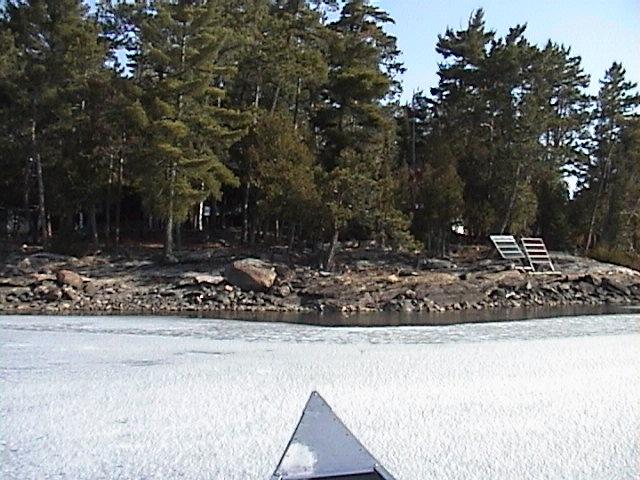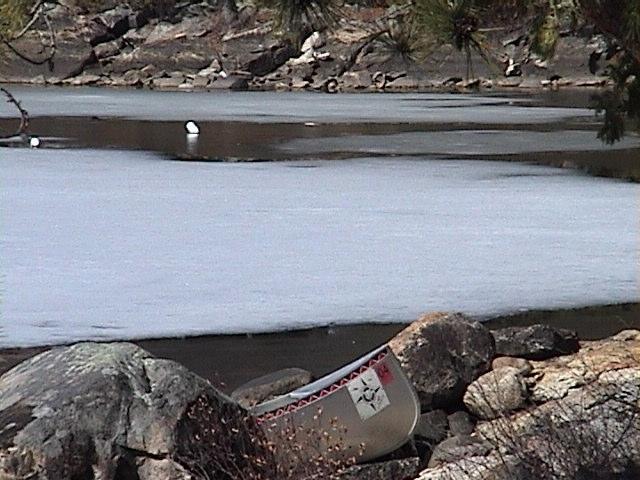My
Grandfather, Art Madsen, established his home and a new livelihood in
the Boundary Waters area in 1931. In 1946 he married Virgina "Dinna"
Clayton. My grandfather lived until July 2000, fully fit and sharp
minded until just short of his 96th year. (For additional information,
see the Boundary Waters Journal Fall 2000, "Canoe Country Legends: The
Original Quetico Ranger" by Helen Sue Manzo).
My grandmother,
Dinna, now 83, still lives at their island and operates their
wilderness resort on the Canadian side of Saganaga Lake named "Sagonto"
(SAGanaga, ONTariO). Sagonto is where I now live full time, assisting
my grandmother in operating the resort.
Grandma Dinna
and I spent freeze up and most of the winter of 2002 and 2003 on the
island. After returning to Minnesota in late April from a two-week
visit to Washington state to help with the Northwoods News 02-03, I
arrived in Grand Marais, MN in anticipation of getting back to Grandma
Dinna and the island.
Not knowing if the ice was still passable, as the
ice had eroded several feet from the shores, I had to make an effort to
get to the island as Grandma was very low in supplies. If I could not
make it up the lake, she would have to wait the two weeks or more it
would take for the frozen channel to become navigable by boat. She had
food to sustain her, but she was not looking forward to having only
wild rice for every meal.
After buying a
couple of apple boxes of groceries and driving up the Gunflint Trail, I
stopped in to visit Bob Monehan who lives on the corridor and radioed
Grandma at the island. She answered with excitement in her voice and
advised me not to try to walk up on the ice towing a sled, but to pull
a canoe instead.
Voyageur's Mike Prom followed up on the radio and
offered to loan a canoe to me if I was in need of one. I gladly
accepted the offer, and in addition he also loaned me a life jacket,
paddles and a spare hand-held marine radio.
I was told it
would be best if I launched from the end of the Sag Lake Trail where
the Seagull River joins the Sag Lake corridor. This saved me over a
mile of walking with the canoe in tow. Unsure and apprehensive of how
successful I would be at ice-to-water transitions; at the shore with
the empty canoe, I practiced with a passing grade, renewed confidence
and great relief to have experienced some of the unknown.
I loaded my
gear and food boxes and drove to the lot to park the car then walked
the mile back and loaded the canoe.

Taking a quick
picture of myself with the ice behind me, I then set out over the ice
at 6:00 P.M. straddling the stern seat, one leg by either side, hunched
over and hands pushing both gunwales.
"I noticed every darkly colored
octopus
pattern and crack that crossed my path...
[I] carefully [moved] the
canoe across the
vertical slivers of
'cocktail ice'
as my
Grandpa Art used to call it, ..."

Tied with a rope
safety line
to the canoe, I took the handle end of a paddle, walked up to the
discoloration and on the third tap the handle plunged through!
The aluminum canoe slid effortlessly on the bare, rough-textured ice.
The newness and potential danger of this experience sharp in my mind,
I noticed a very darkly colored octopus pattern and crack that crossed
my path. Half way to the first narrows I spied a four inch darker band
perpendicular to me stretching left to right. Tied with a rope safety
line to the canoe, I took the handle end of a paddle, walked up to the
discoloration and on the third tap the handle plunged through! The ice
beyond this crack all the way to the open water of the narrows was the
same color as the ice I was standing on, and I hoped this meant it was
also in the same condition to tread upon.
After
carefully moving the canoe across the vertical slivers of "cocktail
ice" as my Grandpa Art used to call it, I
began to walk in front of the canoe, towing it with the line secured
about my waist. As if I was a wilderness tight-rope walker, I walked
with the paddle abreast in each hand to arrest an unforeseen plunge, in
case the ice should give way, which would also spread out my weight on
my exit. With the unusually low snowfall of 02-03, the winter portage,
as I had seen earlier in the month, was bare and I opted to bypass the
muddy portage.




Nearing the
water threshold I pushed the canoe forward and stopped at the point
where half the canoe was in water. After taking a few pictures, I
boarded again and shoved off and paddled a couple hundred feet where I
encountered ice which was too thin to go over and too thick to break
with force.
A beaver surfaced nearby along the shore and I
paddled over to investigate. The ice there had eroded away from shore,
but not far enough out to allow me to pass.

Pushing with my paddle,
medium sized ice sheets gave way and broke free. With weight on the
paddle, the sheets submerged under the ice mass and out of the way
creating a passage past the ice barrier.
About 300 feet
of open water followed until the good ice resumed. I paddled through
the second narrows as 7:30 P.M. approached, and the sun was low in the
sky. Using Voyageur's hand held, I raised Monehan on the radio and
informed him of my decision to stay the night and resume at first
light, when crossing the ice would be relatively safer. Monehan relayed
the news to Grandma and left a phone message in Grand Marais, as
previously planned which my parents could call from Washington to
follow my progress.
Earlier, during the day and under clear skies, the
temperature had been in the mid 50's degree F., but I knew that with a
clear sky at night it would get cold. I heard sounds of a distant
waterfall to the east and decided to explore overland.

Securing the canoe on
shore I set out across the fallen remains of small charred trees not
fully consumed by the corridor fire of 1995. This is the first year
since that I remember the Narrows with a covering of green growth. It
is a beautiful change and renewal from the years of only black, charred
wood and bare rock. A few hundred yards brought me to a small
lakelet—Prayer Lake.
At 8:00 P.M.
sunset came, and I searched through a bag for my spare hat as I had
left my hat and gloves in the car due to the warm temperatures. I had
taken my mom's insulated-rain jacket from the car, and with this, a hat
and the winter clothes I was wearing (boots and snow pants/jacket) I
found a grassy depression 20 feet from the rocky shore and bedded down
on a boat cushion.
"Throughout the night I was awakened
by cold feet and toes...plus animal moans which I discovered
were coming from a few resident beaver...I heard
the sound of
ice breaking before the beaver surfaced and called...I launched the
canoe into the skim of ice that had formed during the night. "
Throughout the night I was awakened by cold feet
and toes (which I kept in continuous, unconscious motion) plus animal
moans which I discovered were coming from a few resident beaver. A
couple of calls and then a tail slap at 11:00 P.M. woke me up, then
again at midnight. I knew it had been cold that night for just before
3:00 A.M. I heard the sound of ice breaking before the beaver surfaced
and called.
The chilling night seemed to drag on. Finally dawn
came, and I gathered my meager bedding and rain jacket which served as
a respiratory heat collector. It was light just after 6:00 A.M., and I
launched the canoe into the skim of ice that had formed during the
night. Later, I learned the overnight temperature had dropped below
freezing at 20 degrees F.
The most challenging part of this perilous trip up
the lake—more so than surviving the night—came
next. I paddled forward, away from shore into the thickening ice.
Unpracticed as I was at transitioning from water-to-ice with a loaded
canoe, I failed in this first attempt by using paddle thrust alone.
Backing the
canoe, I paralleled the shore and broke ice until I was in a shallower
area closer to the thicker, weight bearing ice; about two inches thick.
I angled the canoe again, and by repeatedly pushing in the shallows I
was able to beach the canoe upon the ice.
I did not trust
the stability of the ice that close to open water, so by using an old
style, spade shovel ice auger, I pushed the canoe forward about ten
feet. I got out with a foot on either side and tested the ice.

Progress on the remaining three miles was swift. At four-tenths of a
mile to go, Grandma Dinna was thrilled to hear me call on the radio and
said she did not get a wink of sleep.

Nearing the shores of
Canada and Sagonto at 8:45 A.M., I still had ten feet of water to
cross. What a happy sight it was to see my 81 year old Grandma Dinna
coming down to the shore to greet me.

Thank
you, Voyageur, for the loan of the canoe!

Safely
arrived the next day at the shores of Sagonto.

Dinna
Madsen and her grandson, Marco John Manzo III
at Sagonto, September 2005.



